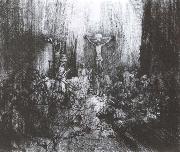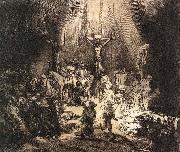Wholesale Oil Painting No Minimum |
|||||||||||
|
|
|||||||||||

|
|||||||||||
|
|
|
||||||||
REMBRANDT Harmenszoon van RijnBorn 1606, Died 1669.One of the great Dutch painters and printmakers of the 17th century, Rembrandt van Rijn is best known for his expressive use of light and shadow (also called chiaroscuro) in his many portraits. Raised in Leiden, he studied with Pieter Lastman (1583-1633) in Amsterdam, then returned to Leiden around 1625 and set up shop as a teacher and portrait artist. Sometime between 1630 and 1632 Rembrandt relocated to Amsterdam, where he spent the rest of his career. Though he had his detractors (some of whom considered him coarse and "low born"), Rembrandt was successful and famous during his lifetime, though he fell on financial hard times in his later years. He was a master printer and produced hundreds of group portraits and historical paintings, including The Anatomy Lesson of Dr. Tulp (1632), The Military Company of Captain Frans Banning Cocq (1642) and Aristotle with a Bust of Homer (1653). His portraits -- including a lifelong trail of intriguing and rather frank self-portraits -- reveal his interest in psychological study and continue to be admired as landmarks in Western art. The Military Company of Captain Frans Banning Cocq is also known as "The Night Watch" because it was thought the painting depicted a nighttime scene. When the painting was cleaned in the 1940s it became obvious that it depicted a daytime scene... He married Saskia van Ulenburgh (also Uylenburgh) in 1634. |
||||||||
|
|
||||||||
The three crosses
The three crosses Painting ID:: 42711 |
MK169
ca. 1660 State iv. Dry needle and etching on paper 38.4x45cm MK169 ca. 1660 State iv. Dry needle and etching on paper 38.4x45cm |
|||||||
|
|
||||||||
RUBENS, Pieter PauwelFlemish Baroque Era Painter, 1577-1640 |
||||||||
|
|
||||||||
|
|
The Three Crosses
The Three Crosses Painting ID:: 43906 |
c. 1620
Oil on canvas c. 1620 Oil on canvas |
||||||
|
|
||||||||
REMBRANDT Harmenszoon van RijnBorn 1606, Died 1669.One of the great Dutch painters and printmakers of the 17th century, Rembrandt van Rijn is best known for his expressive use of light and shadow (also called chiaroscuro) in his many portraits. Raised in Leiden, he studied with Pieter Lastman (1583-1633) in Amsterdam, then returned to Leiden around 1625 and set up shop as a teacher and portrait artist. Sometime between 1630 and 1632 Rembrandt relocated to Amsterdam, where he spent the rest of his career. Though he had his detractors (some of whom considered him coarse and "low born"), Rembrandt was successful and famous during his lifetime, though he fell on financial hard times in his later years. He was a master printer and produced hundreds of group portraits and historical paintings, including The Anatomy Lesson of Dr. Tulp (1632), The Military Company of Captain Frans Banning Cocq (1642) and Aristotle with a Bust of Homer (1653). His portraits -- including a lifelong trail of intriguing and rather frank self-portraits -- reveal his interest in psychological study and continue to be admired as landmarks in Western art. The Military Company of Captain Frans Banning Cocq is also known as "The Night Watch" because it was thought the painting depicted a nighttime scene. When the painting was cleaned in the 1940s it became obvious that it depicted a daytime scene... He married Saskia van Ulenburgh (also Uylenburgh) in 1634. |
||||||||
|
|
||||||||
|
|
The Three Crosses
The Three Crosses Painting ID:: 63956 |
1653 Drypoint and burin printed on vellum, 381 x 438 mm Metropolitan Museum of Art, New York Rembrandt's romance with drypoint in the 1650s and 1660s is one of the important milestones in the history of printmaking. His inventiveness in this medium led to the creation of compositions that offered more complex visual information and variety of drama than previously had been imagined, and whereas earlier intaglio prints had been translucent and in general rather bodiless, Rembrandt's had a structure and richness of surface that approximate many of his great oil paintings. Moreover, they are illumined by an expressive power that never fails to pierce to the heart of things, whether the subject be, as it is here, a momentous scene from Scripture or the simplest study of still life. , Artist: REMBRANDT Harmenszoon van Rijn , The Three Crosses (second state) , 1601-1650 , Dutch , graphics , religious 1653 Drypoint and burin printed on vellum, 381 x 438 mm Metropolitan Museum of Art, New York Rembrandt's romance with drypoint in the 1650s and 1660s is one of the important milestones in the history of printmaking. His inventiveness in this medium led to the creation of compositions that offered more complex visual information and variety of drama than previously had been imagined, and whereas earlier intaglio prints had been translucent and in general rather bodiless, Rembrandt's had a structure and richness of surface that approximate many of his great oil paintings. Moreover, they are illumined by an expressive power that never fails to pierce to the heart of things, whether the subject be, as it is here, a momentous scene from Scripture or the simplest study of still life. , Artist: REMBRANDT Harmenszoon van Rijn , The Three Crosses (second state) , 1601-1650 , Dutch , graphics , religious |
||||||
|
|
||||||||
|
REMBRANDT Harmenszoon van Rijn Born 1606, Died 1669.One of the great Dutch painters and printmakers of the 17th century, Rembrandt van Rijn is best known for his expressive use of light and shadow (also called chiaroscuro) in his many portraits. Raised in Leiden, he studied with Pieter Lastman (1583-1633) in Amsterdam, then returned to Leiden around 1625 and set up shop as a teacher and portrait artist. Sometime between 1630 and 1632 Rembrandt relocated to Amsterdam, where he spent the rest of his career. Though he had his detractors (some of whom considered him coarse and "low born"), Rembrandt was successful and famous during his lifetime, though he fell on financial hard times in his later years. He was a master printer and produced hundreds of group portraits and historical paintings, including The Anatomy Lesson of Dr. Tulp (1632), The Military Company of Captain Frans Banning Cocq (1642) and Aristotle with a Bust of Homer (1653). His portraits -- including a lifelong trail of intriguing and rather frank self-portraits -- reveal his interest in psychological study and continue to be admired as landmarks in Western art. The Military Company of Captain Frans Banning Cocq is also known as "The Night Watch" because it was thought the painting depicted a nighttime scene. When the painting was cleaned in the 1940s it became obvious that it depicted a daytime scene... He married Saskia van Ulenburgh (also Uylenburgh) in 1634. The Three Crosses 1653 Drypoint and burin printed on vellum, 381 x 438 mm Metropolitan Museum of Art, New York Rembrandt's romance with drypoint in the 1650s and 1660s is one of the important milestones in the history of printmaking. His inventiveness in this medium led to the creation of compositions that offered more complex visual information and variety of drama than previously had been imagined, and whereas earlier intaglio prints had been translucent and in general rather bodiless, Rembrandt's had a structure and richness of surface that approximate many of his great oil paintings. Moreover, they are illumined by an expressive power that never fails to pierce to the heart of things, whether the subject be, as it is here, a momentous scene from Scripture or the simplest study of still life. , Artist: REMBRANDT Harmenszoon van Rijn , The Three Crosses (second state) , 1601-1650 , Dutch , graphics , religious |
||||||||
|
|
||||||||
|
Prev Next
|
||||||||
|
|
||||||||
|
Related Paintings to REMBRANDT Harmenszoon van Rijn :. |
||||||||
|
|
||||||||
|
CONTACT US |



